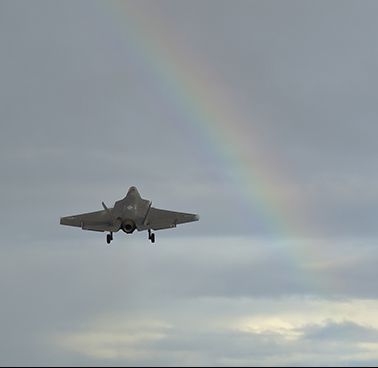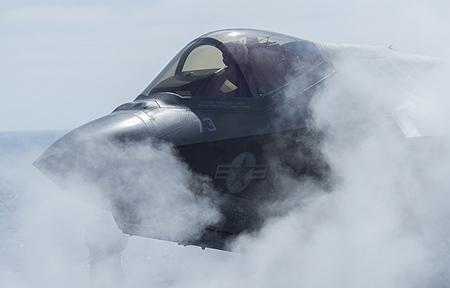The tests were carried out on the B version of the F-35, the short take-off and vertical landing version and, probably, the most complex of the JSF program.
According to the Pentagon, the cell has withstood rain, snow, wind and humidity. According to the Lockheed timeline, the tests will last another two months in a climate laboratory at the Air Force Englin base in Florida.
The fighter - they add from the Pentagon - performed well flying both at temperatures close to 100 degrees and below zero. The final tests foresee a real flight over the Arctic: an extreme test that will sanction the overcoming of the entire cycle of tests.

But it is not the climate tests or the continuous progress of the program that keeps the bench in these weeks, but a problem that if confirmed, would radically change the way of conceiving the JSF.
According to some experts (Lockeed did not confirm or deny it) the F-25 rapid-fire cannon software from 22 mm GAU-35 / A is not yet ready. The connection code between the aircraft's mainframe and the cannon would not have been written yet.
The software code of the F-35 is judged to be so complex that it has been divided into five blocks (each one will give superior capabilities: a different thing, however, is the unification of the systems). The problem is that at the 2015, for the F-35 only the first data block (still slightly unstable) is available, necessary only to make it fly.
The second block should be ready by the 2015 so as to allow the Marines to put the first squadron in line, albeit with "Initial Operational Capacity" for the coming December month.
The third data block should be delivered next year, in time for the entry into service of the first Air Force squadron with "Initial Operating Capacity", scheduled for December of the 2016.
The fourth data block should be delivered in the 2017, while the software necessary to make the cannon operational should not be ready before the 2019, as it is included in the fifth and last package.
 Cannon problems will not affect the Navy, but only because the naval version does not include an internal cannon such as the A and B versions of the F-35. If the problem were confirmed, for a "carelessness" it was decided to implement the cannon fire software only in the fifth data block.
Cannon problems will not affect the Navy, but only because the naval version does not include an internal cannon such as the A and B versions of the F-35. If the problem were confirmed, for a "carelessness" it was decided to implement the cannon fire software only in the fifth data block.
Translated, it means that the Marine Corps, the first to receive the F-35, would have a plane in line that cannot provide troop coverage on the ground (role currently held by the immense A-10).
Summarizing the concept even more: the F-35, a fifth generation fighter designed also for Close Air Support in the twenty-first century, at least until 2019 will not be able to fire a single shot with its cannon. Weapon for dogfight and, mainly for the support of the infantry, which from the beginning aroused perplexity.
We are talking about a cannon capable of firing 3.300 shots per minute, but which will only bring with it 220 ammunition. Also in this case, the data imposes a cynical reasoning: how many passes, over the troops that need coverage, will be able to execute the F-35 with its 220 shots? How many gusts, in a classical context (enemies in numerical superiority) will it be able to fire the fifth generation fighter? And how many strokes can your technological cell take? Perhaps, the main problem of the F-35 is only one: it was meant to be used by the three main branches of the US military, each of which had specific demands. As a result, the aircraft was designed to be a bomber, a fighter and for infantry support.
Why can't the F-35 ever replace the A-10?
The A-10 was designed for one purpose: to survive. It is heavily armored, with armored plates to protect the vital parts of the aircraft. The pilot is protected by a bulletproof roof and is wrapped in a sort of armored titanium “tank” that weighs about 600 kg. The A-10 has been designed to withstand 23 mm and some 57 mm cannons. It can fly with a damaged and partially destroyed wing, a single engine, a single rudder, a single wing. It can fly with the damaged hydraulic system, thanks to reserve mechanical controls. Its winged ends bent downwards, increase lift at low speeds. The main wheels of the trolley protrude from the gondolas when it is retracted: a further guarantee of survival even when the trolley cannot be extended. The F-35 is a fifth generation fighter. It's all about invisibility and avionics, not comparable with any other existing fighter (F-22 excluded). It was designed to impose air supremacy for the next 50 / 60 years. The problem, however, is precisely this: one wonders, what can being "stealth" be in a close combat, almost melee, where armor and firepower are the main and determining role in missions . The F-35 cell was not designed to withstand the fire of the infantry nor to survive the fire of 23 guns. The JSF was born to be elusive and performant in a dogfight, certainly not for Close Air Support. The A-10 has been designed around the seven-barreled GAU-8 Avenger cannon, the most powerful airborne tactical weapon on the planet. It is a gatling type cannon from 30 mm with two firing rates: 2100 or 4200 strokes per minute and can be brought to the maximum firing rate in 0,55 seconds. The ammunition tank carries a maximum of 1350 shots. It is capable of destroying a tank at almost 7 km away. The F-35A is equipped with a Gatling cannon from 25 mm GAU-22 / A with four rotating rods, carried internally. It is capable of firing three thousand shots per minute, with a range of 180 / 220 hits. Beyond the capacity of penetration of the ammunition (inferior to the Avenger), the standard equipment of the F-35A is inferior of almost 10 times in comparison to the A-10. it is one of the most heavily armed aircraft in the US Air Force. It can carry almost 10 thousand and 7 kilos of weapons. The F-500A can carry two air-to-air and two air-to-ground missiles internally. You are the sub alari pillars. It can carry a little over eight thousand kilos of equipment. The Pentagon should buy 35 Joint Strike Fighter for a total cost of 2443 billion dollars, the 400 per cent more than the original projections and for a greater number of aircraft, while the 70 countries allies will purchase 10 fighter jets. The production contract for the Joint Strike Fighter has been awarded to Lockheed in the 721. To date, 2001 fighters have been delivered while development and testing continues. About 109 F-100 pilots have been trained at Englin, including British and Dutch aviators. Much of the training was performed on the simulators, because the aircraft's software is not yet ready. The Air Force will reach the initial operational capacity of the F-35A as soon as the first squadron of 35-12 aircraft is formed, with trained airmen and crews capable of carrying out close air support missions, interdiction and limited suppression and destruction of enemy anti-aircraft defenses. F-24A will reach full initial operational capability between August and December of the 35. Marine equipped with F-2016B, it will reach the initial operational capacity as soon as the first squad consisting of 35-10 aircraft will be formed, with infantry and crews trained to carry out close air support missions, interdiction, armed reconnaissance and support with the land forces. The F-16B will reach full initial operational capacity between July and December of the 35. Finally, the US Navy, equipped with the F-2015C, will reach full initial operational capacity as soon as the first squadron composed of 35 aircraft, with personnel and pilots of the navy trained and able to carry out the assigned missions. The F-10C will reach full initial operational capability between August 35 and February 2018.
The A-10 has been designed around the seven-barreled GAU-8 Avenger cannon, the most powerful airborne tactical weapon on the planet. It is a gatling type cannon from 30 mm with two firing rates: 2100 or 4200 strokes per minute and can be brought to the maximum firing rate in 0,55 seconds. The ammunition tank carries a maximum of 1350 shots. It is capable of destroying a tank at almost 7 km away. The F-35A is equipped with a Gatling cannon from 25 mm GAU-22 / A with four rotating rods, carried internally. It is capable of firing three thousand shots per minute, with a range of 180 / 220 hits. Beyond the capacity of penetration of the ammunition (inferior to the Avenger), the standard equipment of the F-35A is inferior of almost 10 times in comparison to the A-10. it is one of the most heavily armed aircraft in the US Air Force. It can carry almost 10 thousand and 7 kilos of weapons. The F-500A can carry two air-to-air and two air-to-ground missiles internally. You are the sub alari pillars. It can carry a little over eight thousand kilos of equipment. The Pentagon should buy 35 Joint Strike Fighter for a total cost of 2443 billion dollars, the 400 per cent more than the original projections and for a greater number of aircraft, while the 70 countries allies will purchase 10 fighter jets. The production contract for the Joint Strike Fighter has been awarded to Lockheed in the 721. To date, 2001 fighters have been delivered while development and testing continues. About 109 F-100 pilots have been trained at Englin, including British and Dutch aviators. Much of the training was performed on the simulators, because the aircraft's software is not yet ready. The Air Force will reach the initial operational capacity of the F-35A as soon as the first squadron of 35-12 aircraft is formed, with trained airmen and crews capable of carrying out close air support missions, interdiction and limited suppression and destruction of enemy anti-aircraft defenses. F-24A will reach full initial operational capability between August and December of the 35. Marine equipped with F-2016B, it will reach the initial operational capacity as soon as the first squad consisting of 35-10 aircraft will be formed, with infantry and crews trained to carry out close air support missions, interdiction, armed reconnaissance and support with the land forces. The F-16B will reach full initial operational capacity between July and December of the 35. Finally, the US Navy, equipped with the F-2015C, will reach full initial operational capacity as soon as the first squadron composed of 35 aircraft, with personnel and pilots of the navy trained and able to carry out the assigned missions. The F-10C will reach full initial operational capability between August 35 and February 2018.
Franco Iacch
(photo: Lockheed Martin / US DoD)












